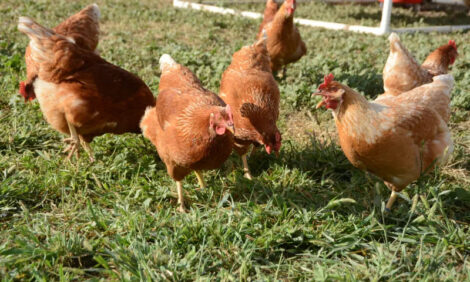



Respiratory Disease on Breeder-Chicken Farms in the United States
The results of a USDA National Animal Health Monitoring System (NAHMS) study of breeder chicken farms in 2010, which examined potential risk factors for respiratory disease relating to farm surroundings, farm/house characteristics, human traffic, birds and other animals on the farm, and bird/egg movement and transport.Breeder-chicken farms consist of primary breeders
whose progeny are breeding birds, and multipliers
whose progeny are broilers and table-egg layers.
Breeder farms provide the genetics for the poultry
industry, and the birds on these farms are very valuable.
Therefore, it is crucial to prevent disease introduction
that could threaten the farms’ genetic stock.
The USDA’s National Animal Health Monitoring
System (NAHMS) conducted a study of breeder-chicken
farms in 2010. A total of 482 breeder farms located in
the Central and East regions of the United States
participated in the study (see map). The study
questionnaire addressed potential risk factors for
respiratory disease relating to farm surroundings,
farm/house characteristics, human traffic, birds and
other animals on the farm, and bird/egg movement and
transport.

Occurrence of Respiratory Disease
Breeder farms placed hens in the laying house at
20.9 weeks of age and removed them at 64.1 weeks of
age, on average.
Breeder farms reported the
occurrence of specific diseases in the last completed
flock, including the following respiratory diseases:
Mycoplasma synoviae (MS), Mycoplasma gallisepticum
(MG), infectious laryngotracheitis (ILT), Newcastle
disease, infectious bronchitis, infectious coryza, and
avian influenza. Respiratory disease occurred rarely (4.6
per cent of last completed flocks). No breeder farms reported MG, Newcastle disease, infectious coryza or
avian influenza in their last completed flock. MS, ILT
and infectious bronchitis occurred in the last completed
flock on 2.0, 1.8, and 0.9 per cent of breeder farms,
respectively (table 1). ILT did not occur in breeder flocks
in the Central region (table 1) or in primary breeder
flocks (table 2). Table-egg type breeder farms had no
occurrences of MS or ILT in the last completed flock
(table 3).
Percentage of farms that had the following respiratory diseases in the last completed flock, by region

Percentage of farms that had the following respiratory diseases in the last completed flock, by farm type

Percentage of farms that had the following respiratory diseases in the last completed flock, by breeder farm type

MS was the only respiratory disease problem in the last completed flock that any breeder farms ranked as moderate or severe (table 4). Slight problems with ILT and infectious bronchitis were reported.
Percentage of breeder farms by severity of respiratory disease problems in the last completed flock

Risk Factors Associated with Respiratory Disease
Figure 1 and table 5 show factors related to
area/farm location that were associated with the
occurrence of respiratory disease in the last completed
flock. Each factor was evaluated individually against the
outcome of respiratory disease.
Results are presented
as odds ratios. The odds ratio is the likelihood of having
respiratory disease for farms with the factor compared
with farms without the factor.
A higher percentage of
farms located in counties with a high density of birds
(poultry) and poultry farms had respiratory disease in the
last completed flock compared with farms in counties
with lower densities of poultry or farms (OR=11.6 and
8.1, respectively). Additionally, a higher percentage of
farms within one mile of another commercial poultry
operation had respiratory disease than farms that were not in such close proximity to another commercial
operation (OR=15.3). A higher density of poultry could
potentially increase the pathogen load as well as
opportunities for exposure to pathogens.
Percentage of farms with respiratory disease in last completed flock, by area/location factors

Percentage of farms with respiratory disease in last completed flock, by area/location factors

Biosecurity practices also impact respiratory
occurrence on breeder farms.
Spraying tyres of feed-delivery
vehicles was associated with a reduced risk of
respiratory disease, while allowing the feed deliverer to
enter the poultry house, using catch crews that catch for
other companies, and using buggies to load egg flats
onto trucks that were used on other farms were all
associated with an increased risk (table 6, figure 2).
Although nearly all farms that used buggies on different
farms cleaned and disinfected the buggies between
farms (97.6 per cent), it may be difficult to remove thoroughly all contamination on buggies, particularly on the
wheels.
Percentage of farms with respiratory disease in last completed flock, by biosecurity characteristics

Percentage of farms with respiratory disease in last completed flock, by biosecurity characteristics

Summary
Movements of people and vehicles were the most important factors related to occurrence of respiratory disease on poultry breeder farms. Breeder farms located in poultry-dense areas need to be especially vigilant about biosecurity measures to prevent introduction of respiratory diseases to their farms.
Further ReadingFind out more information on the diseases mentioned in this article by clicking here. |
September 2012








